Are you a Quiet Speculation member?
If not, now is a perfect time to join up! Our powerful tools, breaking-news analysis, and exclusive Discord channel will make sure you stay up to date and ahead of the curve.
Welcome to the MTGO Market Report as compiled by Matthew Lewis. The report will cover a range of topics, including a summary of set prices and price changes for redeemable sets, a look at the major trends in various Constructed formats and a "Trade of the Week" section that highlights a particular speculative strategy with an example and accompanying explanation.
As always, speculators should take into account their own budgets, risk tolerances and current portfolios before buying or selling any digital objects. Please send questions via private message or post below in the article comments.
Redemption
Below are the total set prices for all redeemable sets on MTGO. All prices are current as of October 2, 2017. The TCGplayer low and TCGplayer mid prices are the sum of each set's individual card prices on TCGplayer, either the low price or the mid price respectively.
All MTGO set prices this week are taken from GoatBot's website, and all weekly changes are now calculated relative to GoatBot's "full set" prices from the previous week. All monthly changes are also relative to the previous month's prices, taken from GoatBot's website at that time. Occasionally, full set prices are not available, and so estimated set prices are used instead. Although both Aether Revolt (AER) and Kaladesh (KLD) are no longer available for redemption, their prices will continue to be tracked while they are in Standard.
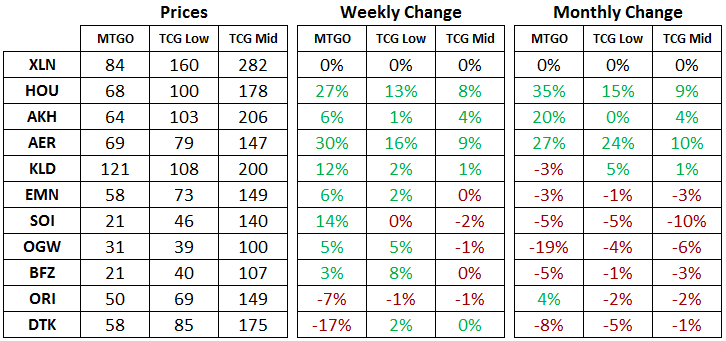
Standard
When it comes to timing the buy side of MTGO speculating, one very straightforward strategy is to target cards and their sets just prior to the release of the next set. This is because drafters are keeping the market well supplied with a steady influx of cards from the packs they have cracked in draft. Once this supply dries up, the price of singles corrects. All Standard sets are flashing green this week on MTGO as prices go through this correction process, though of course the price of Ixalan (XLN) will inevitably fall.
The question of when to sell is another matter entirely. With both Amonkhet (AKH) and Hour of Devastation (HOU) powering into the mid-60-tix price range, timing the sell side of this position has become very relevant. Although I have been happily selling my copies of The Scarab God this week, whether or not to sell my full sets of AKH and HOU is a question in my mind. Selling now might make sense if there were lots of good opportunities to deploy those tix into, but if I am not tix-constrained, then trying to get the highest price would be my best strategy.
In trying to answer the question of when to sell, it's always informative to compile historical data and to see if any patterns emerge, and that's what I've done below. The table gives the price peak and the month of the peak for Khans of Tarkir (KTK) all the way up to the recently rotated Eldritch Moon (EMN). The peak is defined as the highest weekly price (as reported in the MTGO Market Report) after a set is no longer being actively drafted. This covers the last eight sets that were Standard legal.
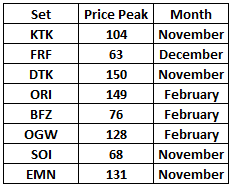
The easiest takeaway from this table is that sets tend to peak in price between November and February. Although trying to grab the absolute price peak might not make sense from an opportunity-cost perspective, it's still informative to see that KLD, AER, AKH and HOU probably haven't seen their highest prices yet.
The one big caveat is that AKH and HOU will go offline for redemption in November. However, full sets of AER and KLD haven't been redeemable since the spring, and that hasn't stopped them from reaching new all-time highs. Redemption is probably a bigger factor on the price floor side of things rather than the price ceiling.
Modern
The rotated Standard sets all saw price increases this week, so at this point it's clear the bottom has been made on these. However, on the paper side of things, TCGplayer mid prices are still falling. Once paper prices stabilize, the path forward to higher prices on the digital side will be clear. I heavily invested in these in the Market Report portfolio, and I am happy with the positions I've taken complete sets of Battle for Zendikar (BFZ), Oath of the Gatewatch (OGW), Shadows over Innistrad (SOI), and Eldritch Moon (EMN).
The big advantage of this strategy is that you are investing in pool of value and you don't care about which cards are seeing play and which cards are out of favor. As long as the redemption process is in place, the pool of value will be maintained.
Otherwise, the switch from tix-only release events to removing release events altogether has meant a much more stable value on tix and thus prices in general. There is no longer a large liquidity crunch with the release of each set. Still, there are players that sell off their Modern singles in order to buy the newest cards, so there are some price dips observed in recent weeks. One example of this is the sudden drop in Scapeshift over the past few weeks. Have a look at the chart below, reproduced from the Goatbots website. This one looks poised to get back to 30 tix sometime over the next six months. I've been a buyer this week.
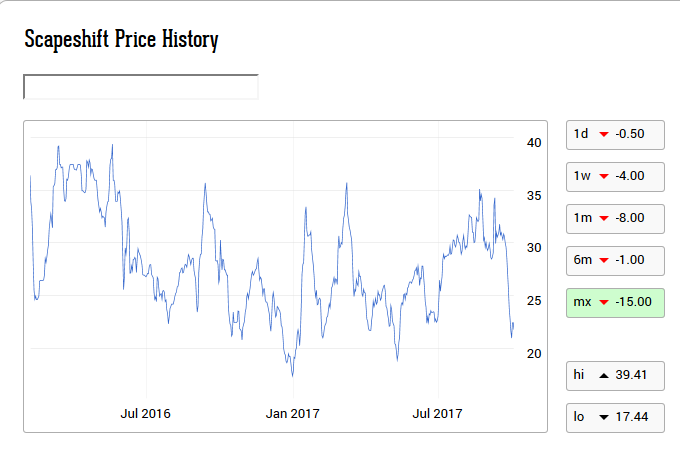
Another card that has seen a big drop in the past week is Mox Opal. Although this card is not a steal at current prices, it's been in a steady uptrend for months, so players who have been itching to sleeve up Affinity or Lantern Control should consider buying their playsets now. With no reprint on the horizon, a return to the 60-plus tix level seems inevitable. The below chart was also reproduced from Goatbots website.
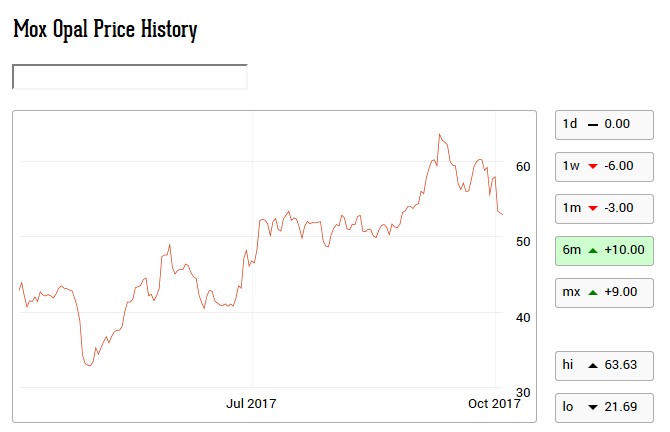
In general, it's a good time for speculators to be buyers of select cards in Modern, but care needs to be taken in choosing which cards to purchase. Recent price dips are a good start, but be sure that the card you are targeting is not being reprinted in Iconic Masters (ICM). Primeval Titan, Thoughtseize and Horizon Canopy should be crossed off the list for the time being. The return of triple Innistrad (ISD) at the end of the month also means to steer clear of Liliana of the Veil, Snapcaster Mage and Geist of Saint Traft.
Trade of the Week
For a complete look at my recent trades, please check out the portfolio. With The Scarab God touching 40 tix this week, I have completely sold off all of my singles of this card. I was selling into the buying strength all week, catching higher and higher prices, which just goes to show you how difficult it is to perfectly time the market. Still, I'd rather be able to sell at a good price than to try to get the perfect price and have difficulty unloading the position into a rapidly changing market.
I've still got a number of copies of The Scarab God tied up in my complete sets of HOU, but I'll be holding onto these for at least a few more weeks. If there was another price jump and this card got into the 50 tix range, I'd be very tempted to sell these copies too.


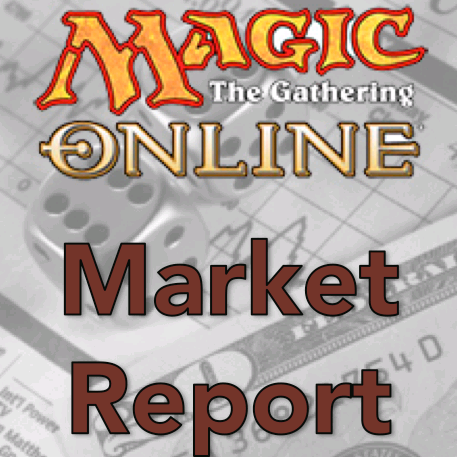





Hey Matt,
Great article this week. Glad to see some nice singles recommendations. Couple questions for you. Heart of Kiran didn’t show up much at all last weekend, cant tell if I should exit the position or hold until the pro tour. Historically the decks from the first SCG event don’t play a big part into the pro tour and post pro tour meta. With the delayed pro tour, do you think those later events leading up to the pro tour will represent a bigger part of the pro tour meta?
Heart of Kiran seems like it is the best card not seeing play in Standard. Since it’s shell has been radically changed by rotation, it will take some time before it finds a home. I would hold for a few weeks and look for a breakout.
Where did you get the information that triple ISD drafts are coming?I could not find it in a wizards article
+1! It is not on the mtgo calendar, neither on the mtgo announcent sor recent mtgo twitter activity 🙁
Check the MTGO announcements in the week of Sept 20.
Actually it’s impossible to find, but Lee Sharpe’s August 2nd article details the flashback formats for both the Standard Gauntlet and Draft.